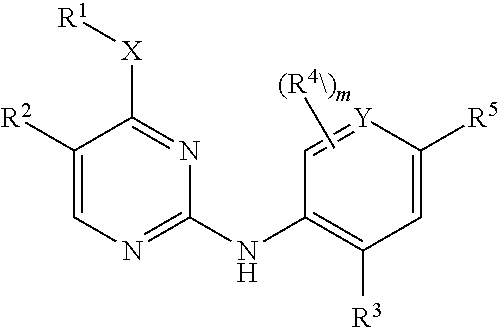Aminopyrimidine derivatives as lrrk2 modulators
a technology of aminopyrimidine and modulator, applied in the field of compounds, can solve the problems of trembling, slow movement, affecting the ability of directing and controlling the movement of the body,
- Summary
- Abstract
- Description
- Claims
- Application Information
AI Technical Summary
Benefits of technology
Problems solved by technology
Method used
Image
Examples
example 1
N2-(2-Chloro-4-(2H-tetrazol-5-yl)phenyl)-N4-methyl-5-(trifluoromethyl)pyrimidine-2,4-diamine
[0384]Step 1: 3-Chloro-4-(4-(methylamino)-5-(trifluoromethyl)pyrimidin-2-ylamino)benzonitrile
[0385]A mixture of 2-chloro-N-methyl-5-(trifluoromethyl)pyrimidin-4-amine (211 mg, 1 mmol), 4-amino-3-chlorobenzonitrile (305 mg, 2 mmol), cesium carbonate (0.65 g, 2 mmol), XantPhos (17 mg, 0.03 mmol) and Pd2(dba)3 (5 mg, 0.02 mmol) in dioxane (3 mL) was sonnicated in an ultrasonic bath for 1 min. The mixture was then degassed under a stream of nitrogen for 5 min. The tube was sealed and the reaction was heated at 100° C. for 18 h. The reaction mixture was cooled and diluted with ethyl acetate (15 mL). The organic layer was washed with water (2×20 mL) and the combined aqueous extracts were further washed with ethyl acetate (2×15 mL). The combined organics were passed through a phase separation cartridge and the solvent removed under reduced pressure. Purification of the residue via silica gel column ...
examples 2 and 3
N2-(2-Chloro-4-(2-methyl-2H-tetrazol-5-yl)phenyl)-N4-methyl-5-(trifluoromethyl)pyrimidine-2,4-diamine and N2-(2-chloro-4-(1-methyl-1H-tetrazol-5-yl)phenyl)-N4-methyl-5-(trifluoromethyl)pyrimidine-2,4-diamine
[0388]
[0389]A mixture of N2-(2-chloro-4-(2H-tetrazol-5-yl)phenyl)-N4-methyl-5-(trifluoromethyl)pyrimidine-2,4-diamine (80 mg, 0.22 mmol), K2CO3 (45 mg, 0.32 mmol) and methyl iodide (15 uL, 0.24 mmol) in acetone (2 mL) was heated at 40° C. for 1 h. The mixture was cooled and filtered. The filtrate was concentrated under reduced pressure and the crude residue purified via silica gel column chromatography (0-100% ethyl acetate / isohexane) to give N2-(2-chloro-4-(2-methyl-2H-tetrazol-5-yl)phenyl)-N4-methyl-5-(trifluoromethyl)pyrimidine-2,4-diamine (58 mg, 70%). LCMS (10 cm_ESCI_Formic_MeCN): [MH+]=385 at 4.31 min. 1H NMR (400 MHz, CDCl3): δ 8.76 (d, J=8.7, 1H); 8.23-8.19 (m, 2H); 8.05 (dd, J=8.7, 2.0, 1H); 7.72 (s, 1H); 5.29 (s, 1H); 4.40 (s, 3H); 3.12 (d, J=4.7, 3H).
[0390]Isomer N2-(...
example 4
N2-(2-Methoxy-4-(1H-1,2,4-triazol-1-yl)phenyl)-N4-methyl-5-(trifluoromethyl)pyrimidine-2,4-diamine
Step 1: 2-Methoxy-4-(1H-1,2,4-triazol-1-yl)aniline
[0391]
[0392]A mixture of 4-bromo-2-methoxyaniline (208 mg, 1.03 mmol), 1,2,4-triazole (80 mg, 1.13 mmol), Cs2CO3 (0.67 g, 2.06 mmol) and CuI (20 mg, 0.103 mmol) in DMF was heated at 110° C. for 20 h. Further portions of 1,2,4-triazole (0.1 g, 1.44 mmol), Cs2CO3 (0.67 g, 2.06 mmol) and CuI (0.1 g, 0.52 mmol) were added and the mixture was heated a further 72 h at 110° C. The mixture was cooled, diluted with ethyl acetate (20 mL) and washed with water (2×20 mL). The combined aqueous washes were re-extracted with ethyl acetate (20 mL). The combined organics were passed through a phase separation cartridge and the solvent removed under reduced pressure. Purification of the residue via silica gel column chromatography (0-100% ethyl acetate / isohexane) gave 2-methoxy-4-(1H-1,2,4-triazol-1-yl)aniline as a light red solid (92 mg, 47%). 1H NMR (40...
PUM
| Property | Measurement | Unit |
|---|---|---|
| temperature | aaaaa | aaaaa |
| temperature | aaaaa | aaaaa |
| temperature | aaaaa | aaaaa |
Abstract
Description
Claims
Application Information
 Login to View More
Login to View More - R&D
- Intellectual Property
- Life Sciences
- Materials
- Tech Scout
- Unparalleled Data Quality
- Higher Quality Content
- 60% Fewer Hallucinations
Browse by: Latest US Patents, China's latest patents, Technical Efficacy Thesaurus, Application Domain, Technology Topic, Popular Technical Reports.
© 2025 PatSnap. All rights reserved.Legal|Privacy policy|Modern Slavery Act Transparency Statement|Sitemap|About US| Contact US: help@patsnap.com



